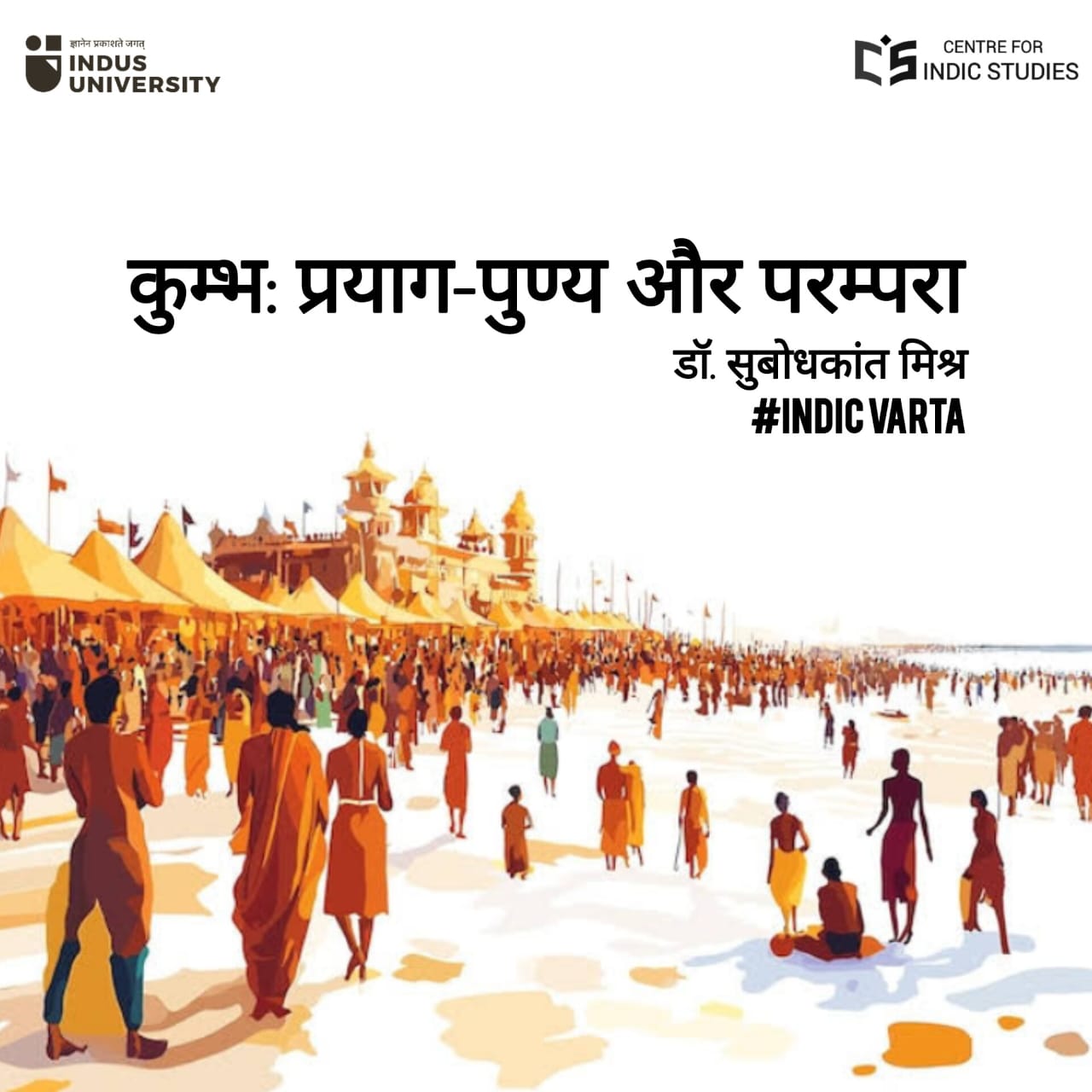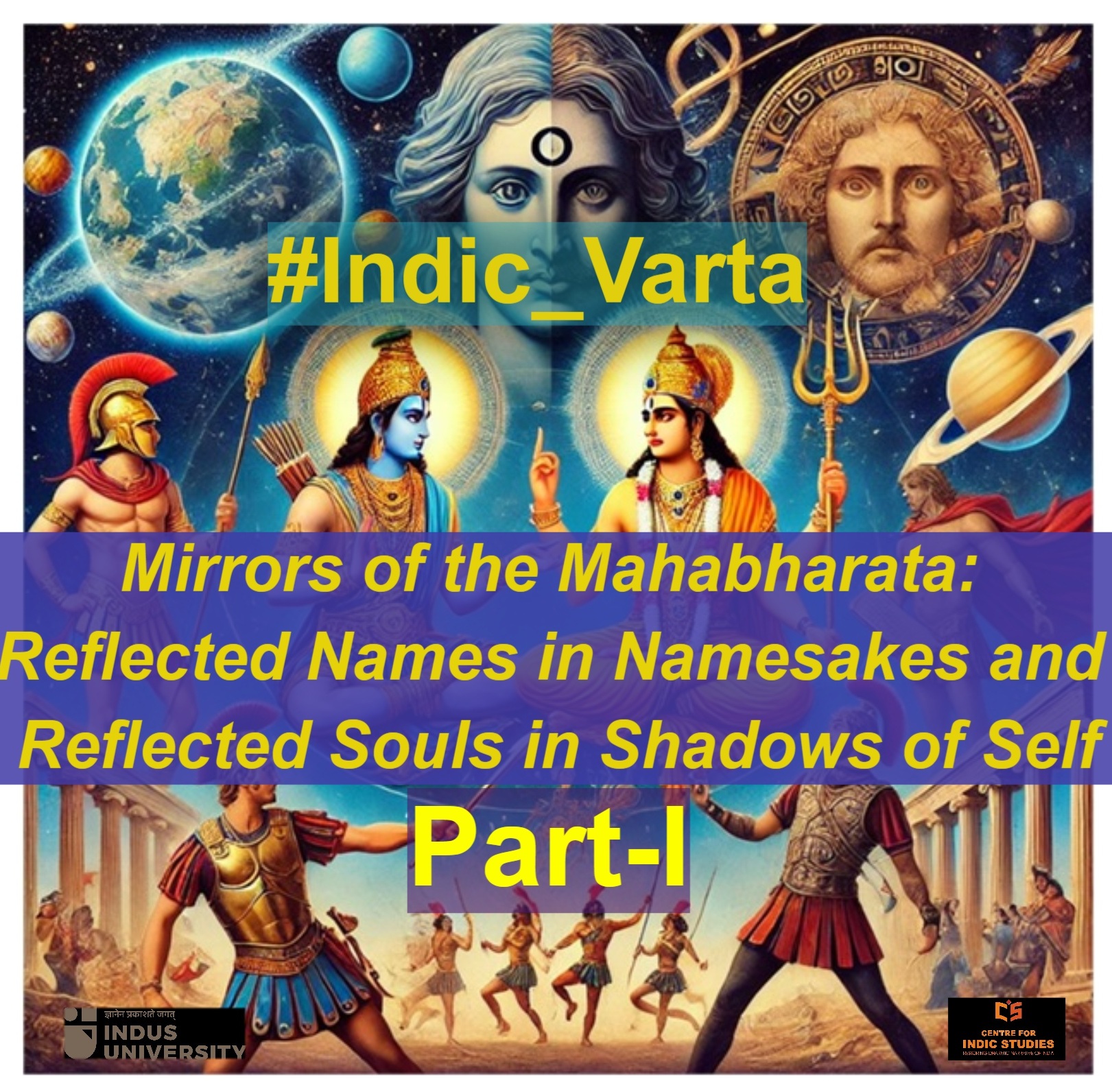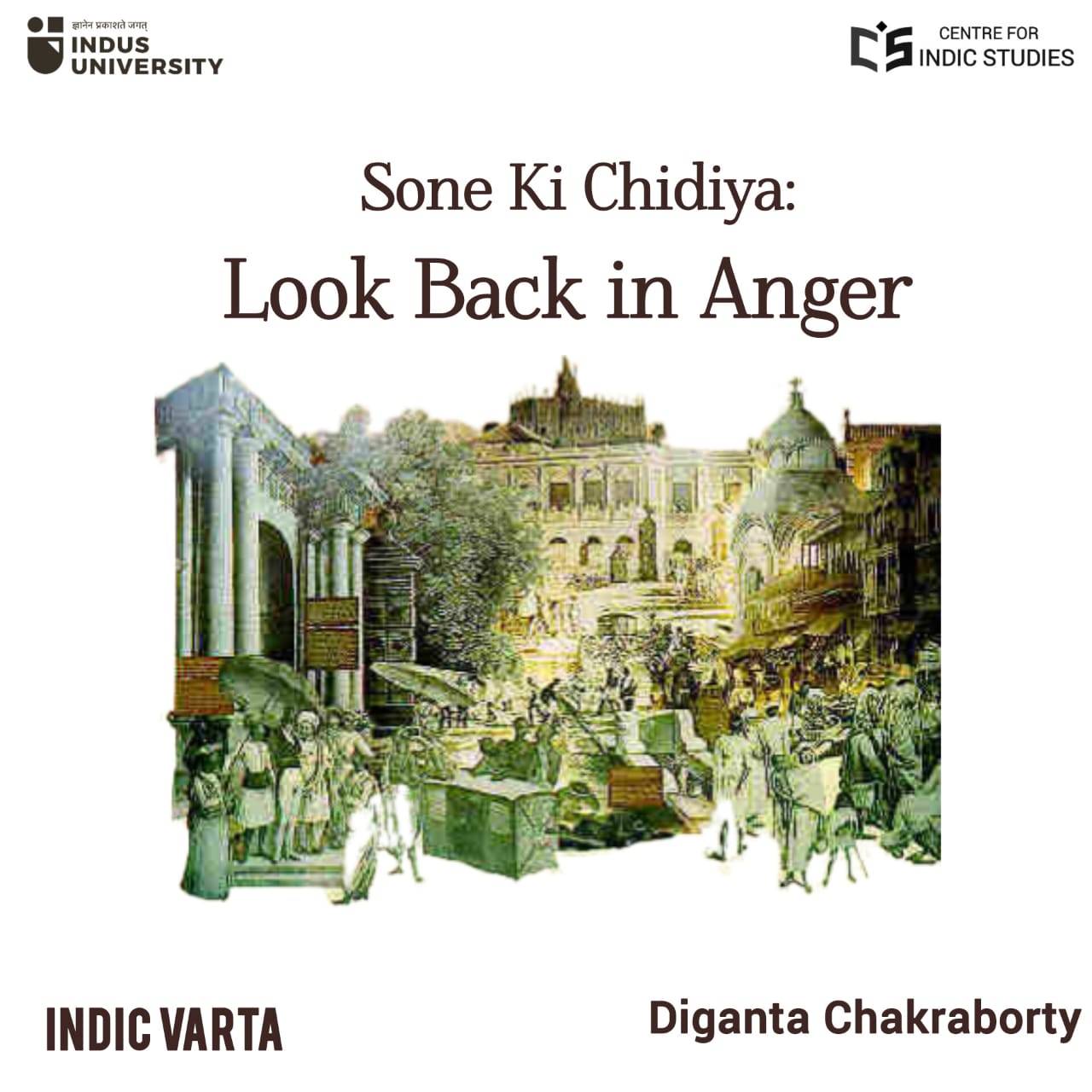- Visitor:63
- Published on:
History of Jagannatha Temple II: The associated legends
The place in the periphery of a kingdom where cities end and villages just merge with woodland- that part of a forest is never very dense. In such a bushy isolated area, Krishna was sitting on a branch of a tree lonely and recalling all the happenings that he had been a part of in his life- waiting for the upalakshya or predetermined event to happen that would make him die! Suddenly a poisonous arrow charged from the bow of a Vyadha or forest hunter stuck his leg.
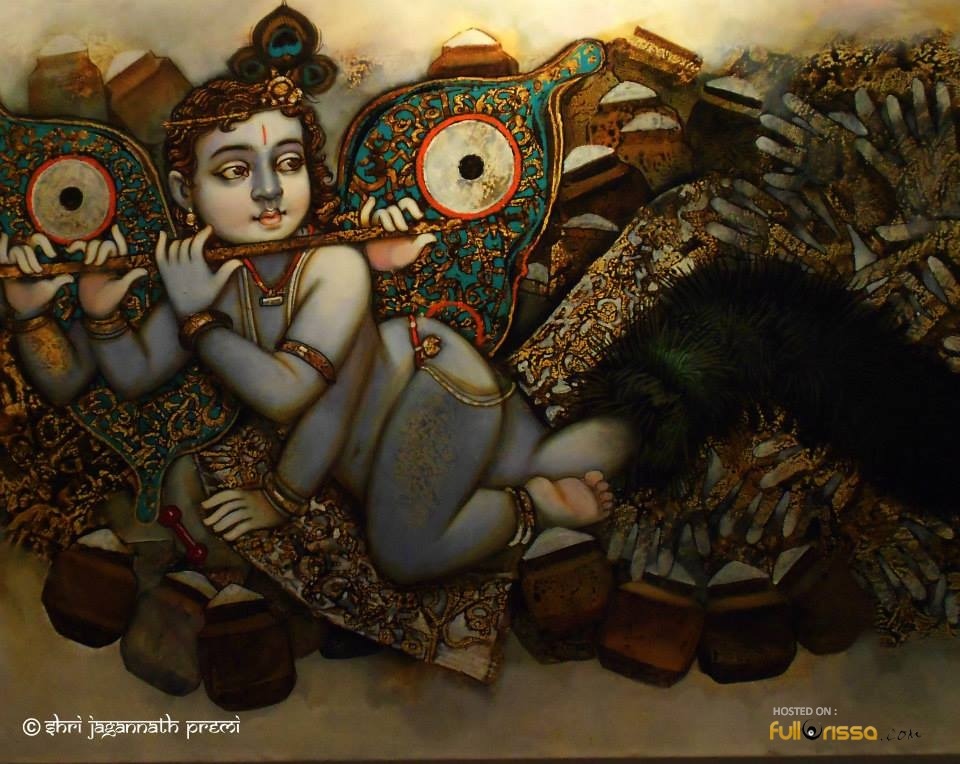
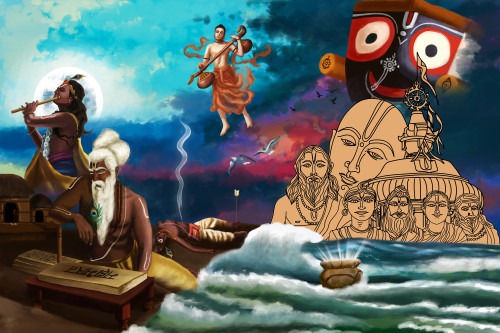
The Mousala Parva of Mahabharata has just ended. It is now time for Sri Krishna to renunciate the world wrapping up all his duties on earth. The place in the periphery of a kingdom where cities end and villages just merge with woodland- that part of a forest is never very dense. In such a bushy isolated area, Krishna was sitting on a branch of a tree lonely and recalling all the happenings that he had been a part of in his life- waiting for the upalakshya or predetermined event to happen that would make him die! Suddenly a poisonous arrow charged from the bow of a Vyadha or forest hunter stuck his leg. The man has mistakenly shot him thinking his hanging red toes to be the ear of a deer from a distance place, filled with leaves and trees in between. Identifying Krishna, he rushed to him and confessed with tears of immense guilt in his eyes, “O Lord, please forgive my ignorance. My name is Jara”. The Lord smiled and assured, “O the self-independent man of my country, I am proud of you. This whole event is preset by divine will. No sin will grasp you. You can continue with your dharma”. Till this, we get from Mahabharata of Sarala Das, Odisha’s own epic poet. Skanda Purana takes this episode further from Mahabharata. From here, it narrates that Arjuna comes and performs the death rite of Krishna. While burning the body, it is seen that his heart was left unburnt. Suddenly a prophecy came from the sky addressing Arjuna, “O hero of the heroes, bind this flesh of heart with a wood and float it in the sea. If you want, carve and draw the Chakra, Shanka, Gada, Padma- the signs of Narayana on the wood”. Yes, this is the Darubrahma that came floating to Indradyumna and on which the mysterious man was working closing the doors. It is also mentioned that Jara was reborn as Sabar Viswabasu this time, whom we have known as the most committed devotee of Nilamadhava.

Now, the scene was shocking and made the king and all others present there stunned! Yes, the Darubrahma is broken and turned into the shape of three idols. But as Indradyumna stepped forward to examine the figures properly, he saw that the Srimurtis are not properly generated. The man has left behind three idols for him with no hand and leg!

Actually, as two weeks passed, the king could not control his anxiousness. Till now everyone was able to hear the sound- ‘tik tik tik’ of the chisel and hammer. Suddenly, on the 14th day, silence came down from the place. He and his wife Queen Gundicha became more and more nervous with every passing moment of silence. They turned impatient and doubtful about whether the old sculptur’s health had taken a toll on his work or anything very bad had happened there. With his hand on the handle, the King put his ear through the door.
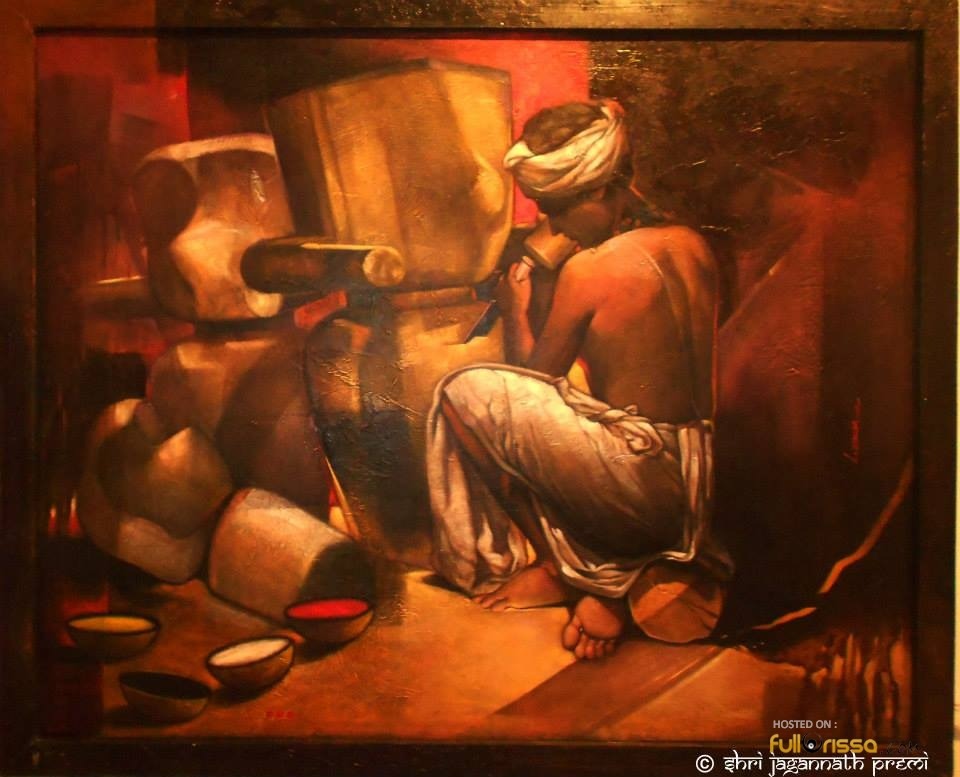
Though the ministers prohibited him repeatedly and even his queen adviced him to take some more time, he had desperately opened the doors. His ears clearly heard the cleaking sound of the swing spread with his hands, but his eyes could not see the man in proper place. It was quite understandable that till the portions that were visible, the idols were complete and the artist kept his word by disappearing from there. In immense guilt of being ignorant, Indradyumna again decided to give up his life regretting for his rash decision this time and went to sleep on a bed of grasses that night.
Again, Sri Jagannatha arrived in his dream and stated, “From now, as a savior of the fallen ones, I will be present here in this handicapped form. Though I am incomplete here, but I will definitely accept the complete offerings of my devotees and will spread my spiritual beauty all the time on this land of Nilachal hereafter”. The king thanked the God and prayed for the people without whom he could not have seen this day.
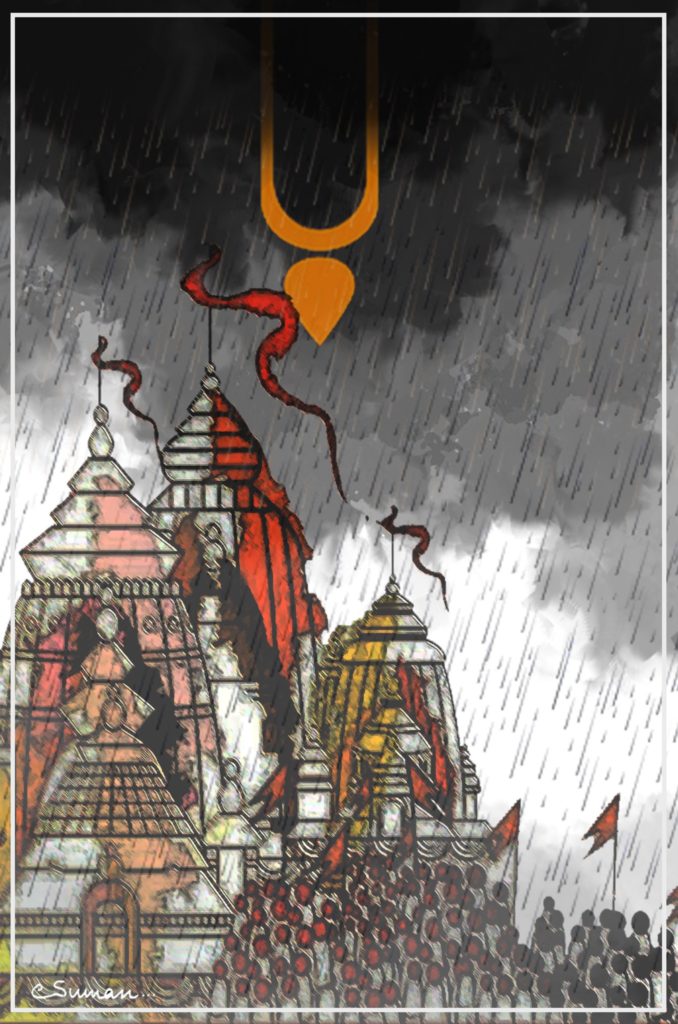
Satisfied with his words the Lord declared, “The sutradhar named Ananta Maharana has manifested me with his talent and from now, his descendants will create my chariots during festivals every year. Viswabasu’s progeny will serve my temple and will be called Dwaita Sevak. Vidyapati’s offspring from his earlier Brahmin wife will worship me whereas the children from his Shabar wife will prepare my food in the name of Supakar. But, now o king, please pray something for yourself”. Taking all the orders in his head and idolizing what Sri Krishna wanted for his Vrishni clan, Indradyumna requested, “Let nobody claim the properties of the temple after my death. To maintain peace here, make me remain childless”.
This is the standard narration that we get to know today regarding the legends related to the temple. Now, let us look at various descriptions and variations of the story as seen from different important scriptures.
| Narada Purana | According to Narada Purana, in response to Laxmi Devi’s question, once Sri Narayana replied, “In the unique holy pilgrimage site named Purushottam, I myself is manifested in the idol. Those who take a glance of me come directly to Vaikuntha”. During Satya Yuga, king Indradyumna came to Srikshetra and performed Aswamedha Yagna, desperate to meet Narayana, donated land to Brahmins and built a palace. Worried about where to place the murti he came to the sea shore as directed in his dreams. There he found an extraordinary large tree and Vishnu standing in the form of a Brahmin along with Viswakarma. As per the Lord’s will, Viswakarma carved out the 3 idols that we see today. |
| Utkal Khanda of Skanda Purana | As mentioned in Skanda Purana, after the creation of the earth, Brahma was planning for salvation of the creatures and went to ask Lord Vishnu. From Him, He came to know about the secret and rare piece of land of Purushottam Kshetra near the sea shore at the Nila Parvat, where Vishnu spreads his divine presence daily. There He found a crow taking bath and drinking water from Rohini Kund and then attaining liberation. Even, the common people used to ignore Yama with no fear of arrival of the God of death in that area. Sri Laxmi informed Brahma that this happening is beyond Yama’s reach and God would eventually be established by the efforts of King Indradyumna. |
| Niladri Mahoday | In the 4th volume of this book the Lord, Sri Jagannath, Baladev, Subhadra, Sudarshan, Viswadhatri, Laksmi and Madhava appeared there on a throne of jewels as seven idols. They are described as follows. Seated in the lotus posture of Yoga, the blue-colored Jagannath with two hands raised, has lotus eyes and the lotus in his hand were hidden. Subhadra’s idol is red in color and the lotus in her hand is partly displayed and Balarama is white colored like a conch shell, with wide lotus eyes, two hands are only seen raised out of four and legs are seen with head surrounded by serpents. Sudharshan stands like a pillar and seems to have conquered all senses with pride, while Madhava’s dimension is short. The smiling Laxmi is also seated in lotus posture, with blue lotus in her two hands, and providing assurance to the world and blessings with the other two and welcomed by four elephants with golden jugs filled with nectar of immortality. Devi Viswadhatri is also seated in that same posture and manifested with glory in white color and holding a lotus in one hand, providing knowledge through the figures of the second hand. But, here also the artist has disappeared leaving these half-built forms incomplete on the 5th day of his task. |
| Padmapurana | The book states that Ratnagriva, the ruler of Kanchi lost interest in life after ruling for many years. Once, he got a vision of an ascetic Brahmin man in a dream who in reality appeared at his royal court the next day. He informed the king about Sri Purushottam at Nil Parvat. He also stated that everyone from the tribal Bhil community in that region also possesses four hands. Once, a Bhil boy named Prithu climbed an apple tree and found a golden Vishnu temple adorned with jewels. He entered the temple in curiosity, faced the Lord’s idol and eating a food offering lying on the floor turned into a four-handed human. Following his incident, other people in his community also developed extra two hands for them. Thus, the temple was found and established after clearing the forest by the Bhils. However, this temple was built by Indradyumna as ordered in his dream which is known from a popular book in Oriya named Deaula Tola by Nilamber Das. He brought stones from a place called Baulmala for the construction and built them at Sankhanavi Mandap of Srikshetra and established a village named Ramakrishnapur. A pitcher and wheel were already present at the top of the temple. Meanwhile, he had gone to Brahmaloka to invite Brahma. Hence, a lot of time passed there and the temple sank inside sands. In the meantime, many kings like Surdev and Galamadhav were ruling their kingdoms. One day, while he was passing across this area, his horse’s hooves stuck on the land. The chakra or wheel of the temple was lying beneath the earth. As Galamadhav removed the sand and revived the temple, Indradyumna returned and got indulged in a conflict with him regarding who has actually constructed the building. To judge and know the truth, they all visited a crow and a group of tortoises who were living in that area for a long period of time. A saying was there that those tortoises were none other than the people who carried stones for Indradymna and the crow‘s name was Bhusandi, who has been chanting the name of Lord Rama for ages, from that time, living on Kalpa Bata, a banyan tree. They all confessed that it was Indradyumna’s task. Hence, Galamadhava was punished to stay on the western side of the lake Indradyumna-Sarovara, outside the temple at the command of Brahma for hiding the truth. |
| Mahabharata by the great poet Sarladas | Here also, the history of this temple is described connecting various episodes of mystery behind the idol of Nilmadhav, the union of Viswa and Vasu, fight between Arjuna and Jara on the idol of Sri Krishna and lastly throwing of the half-burnt lump of cooked rice offered in the death ritual of Krishna in the sea by them. |

It is evident from all these scriptures that construction and renovations were done by many rulers who have their own backgrounds as retold in the descriptions. Keeping all the legends in mind, some common features attracts our attention.
- Darubrahma- from where the idols are carved.
- It was worshipped initially by the local tribals as Vishnu.
- Role of a mysterious person in creating the figures- who is identified as Lord Viswakarma or Jagannatha himself!
- Connection between Krishna and Jagannatha and hence a link with the Vaishnava cult.
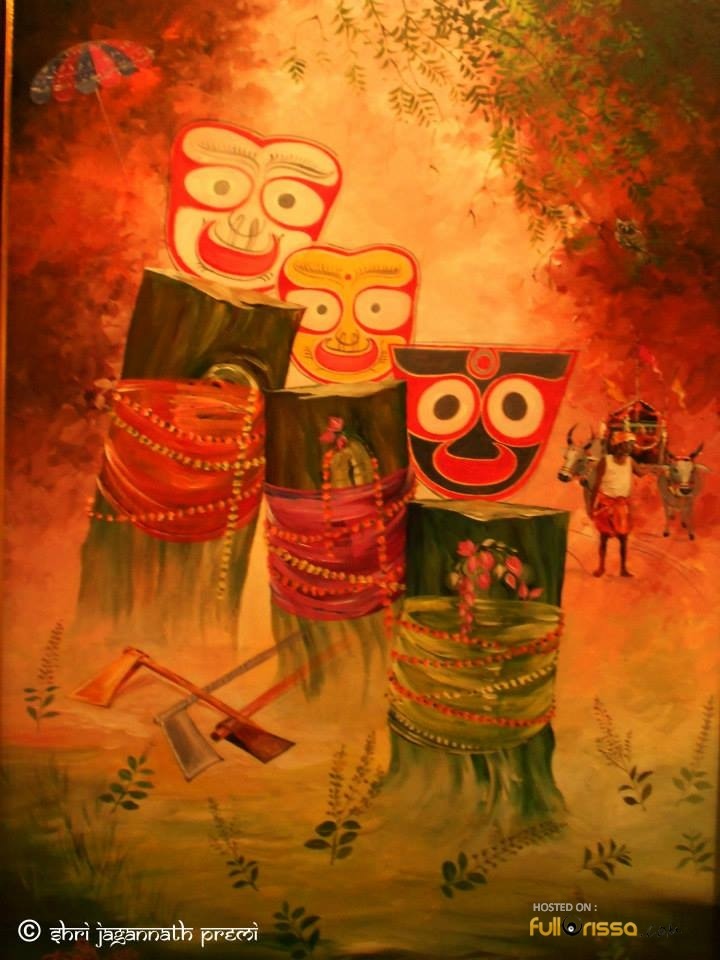
The tradition of ‘Ado Jaddaru Plabate’ as mentioned in the Vedas is thus maintained uninterrupted by later day poets and writers through the tales of Krishna’s body parts and Nilmadhava coming as Darubrahma. It becomes the merging and brotherhood of both Vedic and Non-Vedic schools along with both form and formless traditions. Historically, the current temple that we now see was built during 1042-1112 CE under the reign of Anantavarman Chora Gangadeva. After the former building was on its last legs over time, Choraganga, the Ganga dynasty emperor developed the present large skyscraper temple. Next, Sri Aangabheem, a king and yogi sustained its security, service, worshipping and maintenance spending lakhs of gold coins. Further, powerful rulers like Kapilendradev and Purushottamdev of the solar dynasty resisted the foreign attacks on Hindus and Hinduism and protected the place continuing the message of peace and friendship through the symbols of Jagannatha across India. Lastly, king Ramachandradeva of the Bhoi dynasty re-designed and re-established the idols by driving away Islamic forces in 1575. For this, he is also entitled as the second Indradyumna.
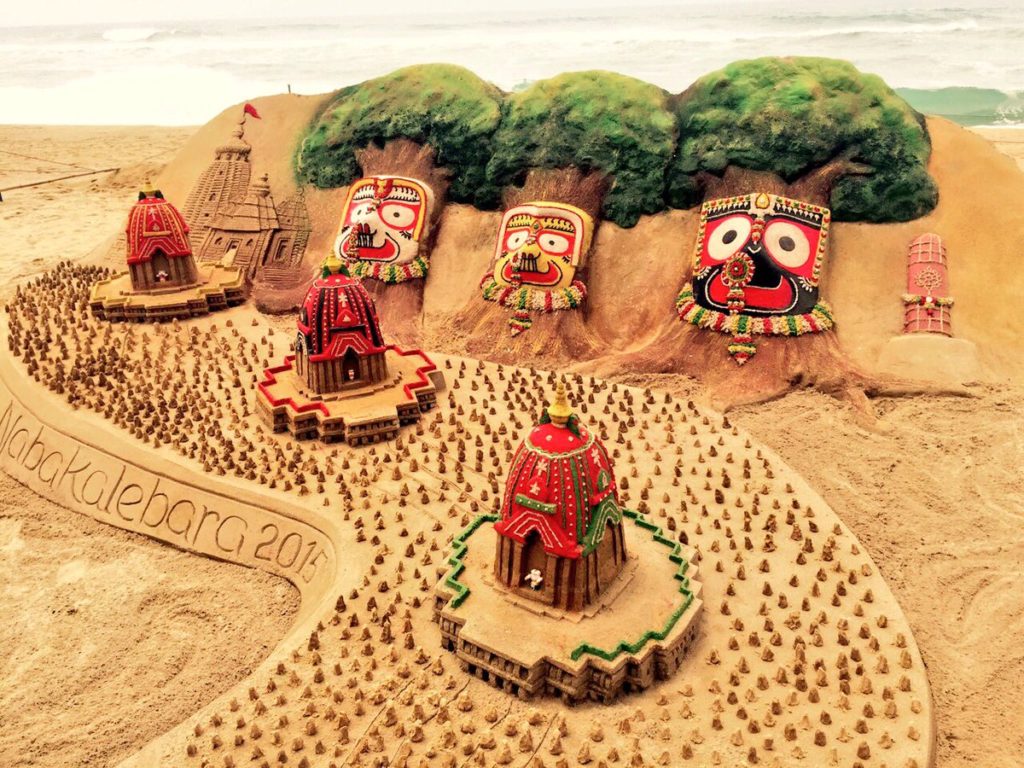
Above all, lastly, let’s not forget the contribution and efforts of Vidyapati in the whole tale. He came from an outside kingdom and culture, in search of God, maybe partly because of royal order or partly being anxious and driven by inner devotion. But, it was only he, not Indradyumna and his men, who got the view of God in pure form. He was ignorant of the path of his journey being blindfolded and so, his entire trip was incomplete like how Jagannatha had come to others and even to us today, in a partial form.
The scattering of mustard seeds presents his identity as an intelligent man but at the same time this spreading and leaving the signs of union behind on the road reminds us of some verses translated from a poetry-Aparichita (Purabi) by fervent lover and poet Rabindranath Tagore:
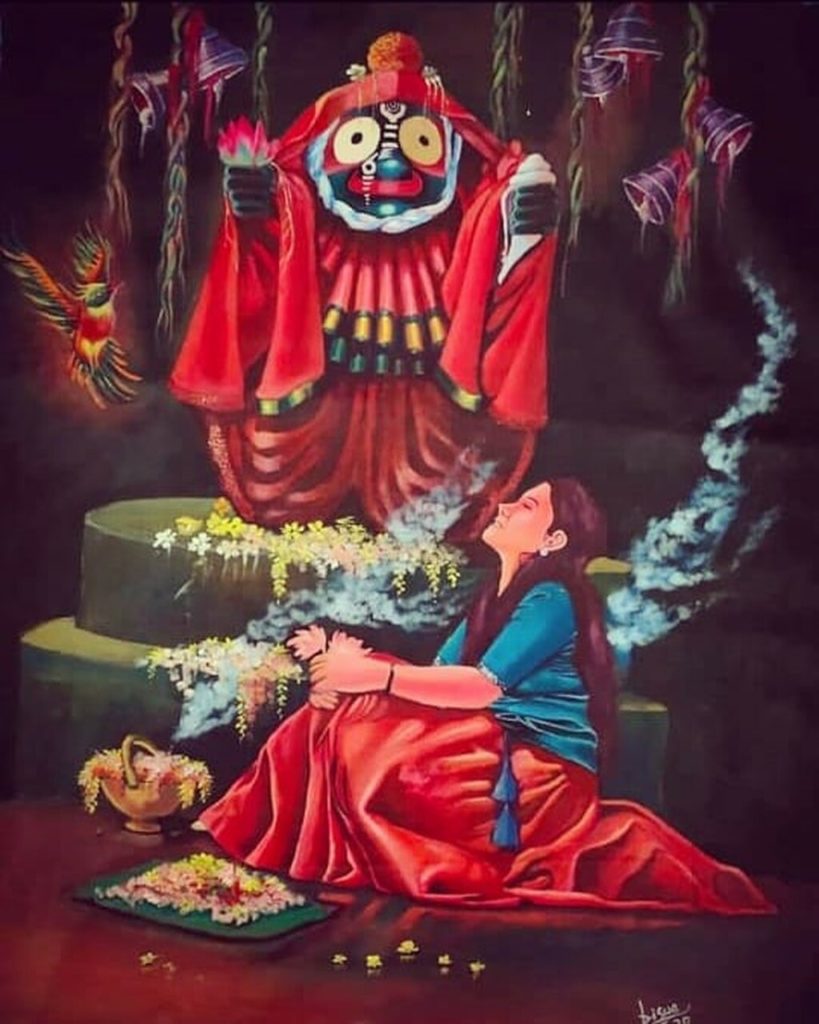
“From that day on, your dream in my half-asleep state in the dawn
It may be painted in the redness of pain
Where partial desire and partly forgetting were weaving the connection
But we were still not known to each other
So this time along your path
Leaving behind all the songs that I could make!”
Jai Jagannatha!!!
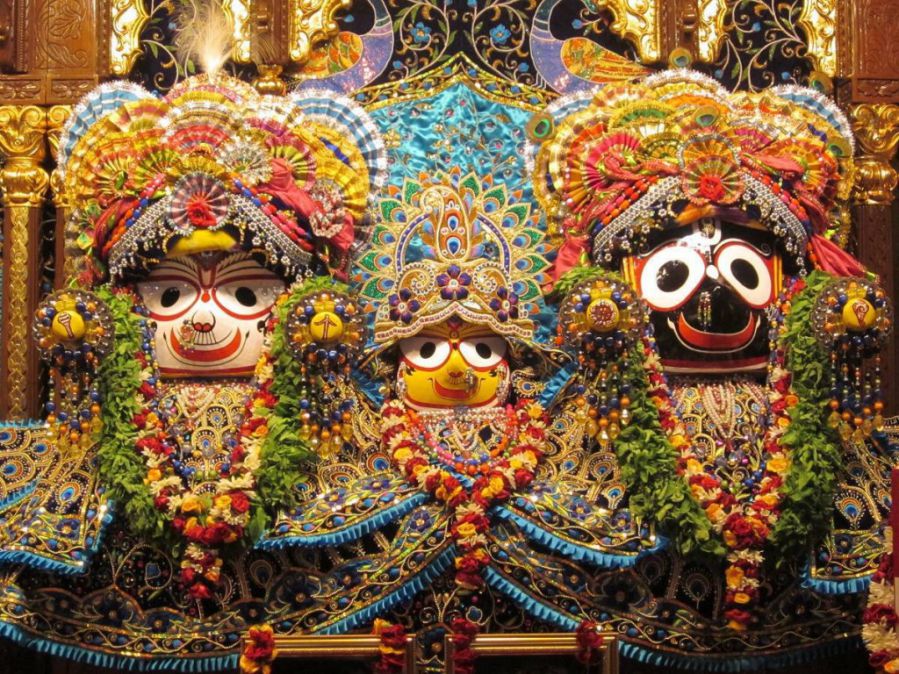
References:
Sri Sri Jagannathdeber Nabakalebar (Bengali) by Professor Sri Khnucharan Mishra, translated by Sri Radhakrishna Hazra
Srikshetra (Bengali) by Srimat Sundarananda Bidyabinod
Chaitanyer Jagannath || History of Rathayatra Part-6 || Nrisingha Prasad Bhaduri https://www.youtube.com/watch?v=QDcn35MwdrY
http://magazines.odisha.gov.in/Orissareview/june_july-2007/engpdf/Pages88-90. pdf
What is the true story on The Appearance of Lord Jagannatha at Puri?
https://avanti.org.uk/kapsharrow/wp-content/uploads/sites/8/2020/06/Jagannath-story.pdf
http://manasranjanpandablog2.blogspot.com/2014/07/manasranjanpandablog2.blogspot.com-2014-07-Neel-Madhav.html
Images:
https:/ /twitter.com/sudarsansand/status/749074434951000064
https:/ /www.templepurohit.com/hindu-temple/jagannath-temple-puri/
Suman Das https://www.facebook.com/sourav.bhattacharya.125/posts/pfbid02yZYMq4PuXjpmBAuHkKy1PV4BbEdefQBkRuiU8x6E5CC3DYFecyvHEFbTKcxfBwFHl
https://www.artranked.com/topic/Lord+Jagannath
https://www.fizdi.com/search.php?search_query=jagannath§ion=product
Center for Indic Studies is now on Telegram. For regular updates on Indic Varta, Indic Talks and Indic Courses at CIS, please subscribe to our telegram channel !
- 31 min read
- 0
- 0







